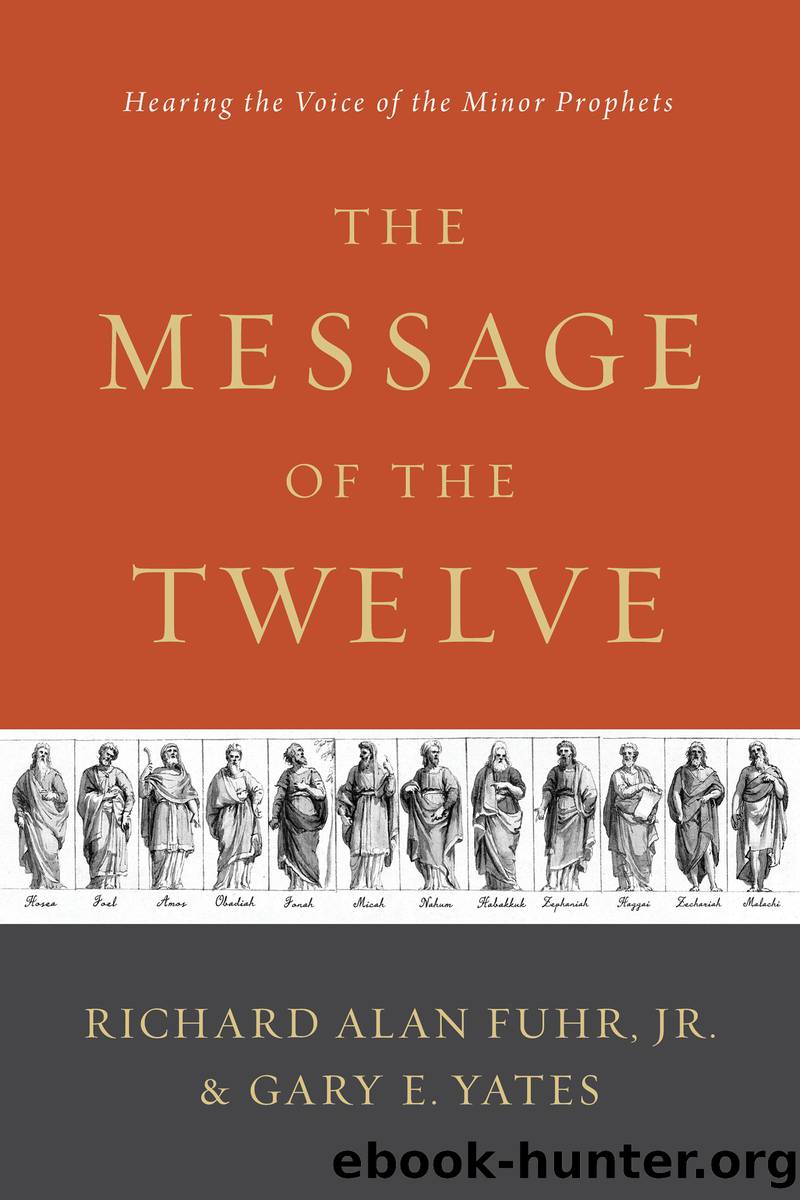The Message of the Twelve by Fuhr Al;Yates Gary; & Gary Yates

Author:Fuhr, Al;Yates, Gary; & Gary Yates
Language: eng
Format: epub
Tags: Religion/Biblical Studies/Old Testament
Publisher: B&H Publishing Group
Published: 2016-09-02T00:00:00+00:00
Prophesies often included near and far fulfillments without the prophet necessarily understanding that they were separate events or that these events were separated by long periods of time. In Micah, the judgments of the Assyrian and Babylonian crises anticipate the judgment of the last days, and the deliverance of Jerusalem in 701 BC anticipates the final deliverance of Godâs people and the coming of Messiah to rule over the earth.
The âOn that dayâ in verse 6 continues the focus on Israelâs glorious future. The Lord promises to re-gather his people from exile like a shepherd tending to the crippled and lame in his flock (see 2:12â13; Isa 40:11). The âremnantâ of survivors from the exile would become a âstrong nation.â The dominion of Jerusalem would be restored, and the city would become like a âwatchtowerâ from which the Lord would watch over his people and protect them from their enemies.
THE STRUCTURE OF MICAH 4:9â5:6
Like the book as a whole, this section of the book contains alternating messages of judgment and salvation.
4:9â10 4:11â13 5:1â6
`attah Zion in labor pains/ sent away into exile (4:9) `attah Nations besiege Zion and seek to defile her (4:11) `attah Zion under siege and the humiliation of her ruler (5:1)
Zion delivered from exile (4:10) Zion tramples and crushes her enemies (4:12â13) The promise of a new David and the defeat of Zionâs enemies.(5:2â6)
4:9â10 âYou will go to Babylon; there you will be rescuedâ (Judahâs Coming Exile and Future Restoration)
The tone and imagery changes dramatically as the prophet shifts back to the present distress in 4:9â5:1. This section is further divided into three oracles, each introduced by ânowâ (`attah), that contrast Judahâs present distress and its future salvation.
In verses 9â10, Daughter Zion is portrayed as a woman in labor, crying out in pain as she is deprived of her king and led away into exile. The image of Zion as a mother in labor is ironic in that many of her residents would be killed or taken away in exile. The prophetâs rhetorical, âIs there no king with you?â mocks the people for the misplaced confidence they had put in human kings and military strategies rather than in the Lord. Jerusalem was under assault by the Assyrians in Micahâs day, but the prophet looks forward to the future exile in Babylon more than a century later. Babylon was already on the scene in Micahâs day and attempted, under its king Merodach-baladan, to lead the resistance against Assyria. When Hezekiah foolishly showed the treasures of his kingdom to the Babylonian envoys, Isaiah warned that the Babylonians would later return to plunder Jerusalem and take captives from the people of Judah (see Isaiah 39). Micah promises that the Lord would ultimately ârescueâ (natsal) and âredeemâ (gaâal) Israel from Babylon, using language associated with the exodus from Egypt (see Exod 3:8; 6:6; 15:13).
4:11â13 âMany nations have now assembled against youâ (Jerusalemâs Present Distress Under Enemy
Download
This site does not store any files on its server. We only index and link to content provided by other sites. Please contact the content providers to delete copyright contents if any and email us, we'll remove relevant links or contents immediately.
The Five People You Meet in Heaven by Mitch Albom(2853)
Name Book, The: Over 10,000 Names--Their Meanings, Origins, and Spiritual Significance by Astoria Dorothy(2500)
Real Sex by Lauren F. Winner(2487)
The Holy Spirit by Billy Graham(2433)
The Secret Power of Speaking God's Word by Joyce Meyer(2264)
0041152001443424520 .pdf by Unknown(2230)
How The Mind Works by Steven Pinker(2228)
ESV Study Bible by Crossway(2146)
Ancient Worlds by Michael Scott(2113)
The Meaning of the Library by unknow(2078)
The Gnostic Gospels by Pagels Elaine(2039)
Churchill by Paul Johnson(2019)
MOSES THE EGYPTIAN by Jan Assmann(1981)
The ESV Study Bible by Crossway Bibles(1964)
Jesus by Paul Johnson(1895)
Ancient Near Eastern Thought and the Old Testament by John H. Walton(1857)
The Nativity by Geza Vermes(1855)
The Complete Dead Sea Scrolls in English (7th Edition) (Penguin Classics) by Geza Vermes(1852)
City of Stairs by Robert Jackson Bennett(1842)
